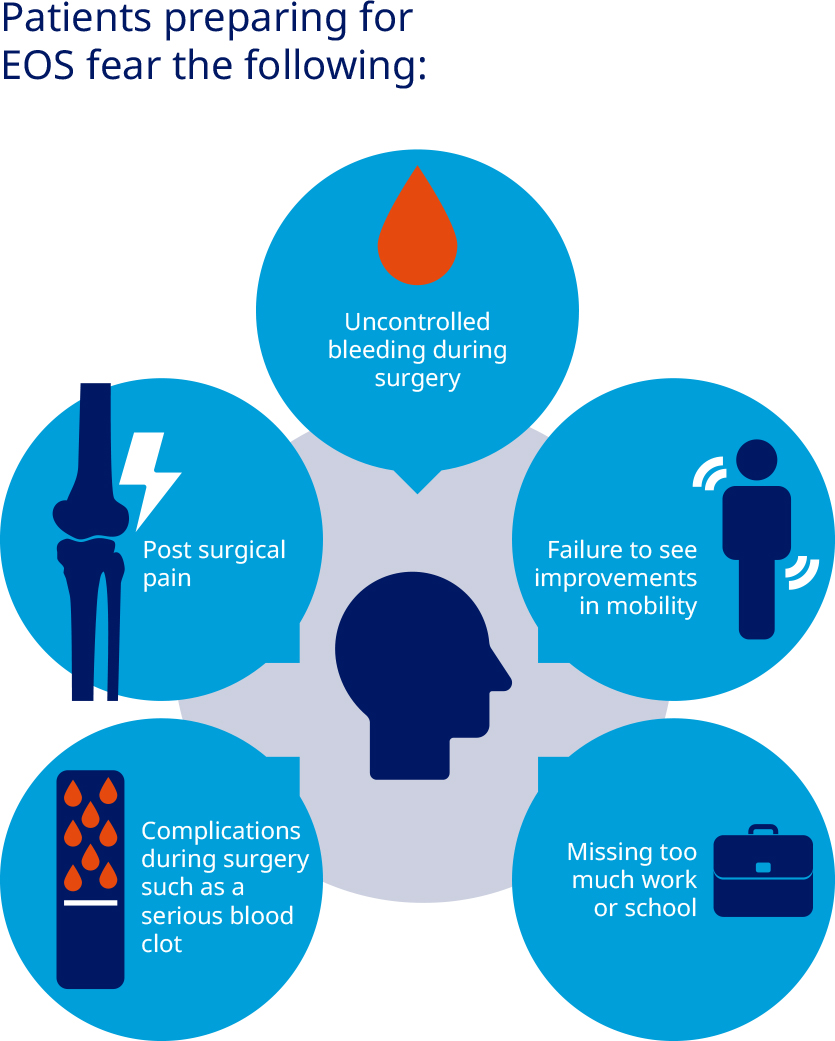
Let's start the EOS conversation
We're here to support you with our eligibility checklist and conversation starter tool
AGREE OPTIONS WITH YOUR HEALTHCARE TEAM
CHECK YOUR READINESS FOR SURGERY
TAKE THE RECOMMENDED STEPS
In patients with severe haemophilia joint haemorrhage makes up more than 80% of bleeding episodes (mainly elbows, knees and ankles),1 and many patients will develop one or more ‘target joints’ that carry an increased risk of recurrent bleeds.2
Recurrent haemarthroses in target joints may evolve over years towards chronic arthropathy with cartilage damage, the narrowing of joint space and, ultimately, bone deterioration.2 The development of arthropathy is one of the most common and debilitating clinical manifestations of haemophilia, leading to complications such as joint pain and reduced joint mobility.2,3
EOS can offer potential benefits for patients, improving health-related quality of life and reducing pain and discomfort.4 Advances in treatments and orthopaedic surgery mean that EOS procedures can even be considered in complex cases; however, some patients’ barriers to undergo EOS remain.5-7
Advances in treatment, combined with advances in orthopaedic surgery means that orthopaedic surgical procedures can be considered, even in the most complex cases.8 In patients with inhibitors, EOS will require more careful preparation and should only be undertaken by a multidisciplinary team (MDT) experienced in this area, at a specialised haemophilia treatment centre with a comprehensive care model.9
1. Rodriguez-Merchan EC, et al. Haemophilia 2011;17:1–23.
2. Knobe K & Berntorp E. Journal of Comorbidity 2011;1:51–59.
3. Lobet S, et al. J Blood Med 2014;5:207–18.
4. Canadian Hemophilia Society. A Guide on Orthopedic Surgery for People with Hemophilia. Available from: https://www.hemophilia.ca/files/Challenges-Choices-Decisions%20 Hemophilia.pdf [Last accessed January 2021].
5. Rodriguez-Merchan EC, et al. Haemophilia 2007;13,613–619.
6. Srivastava A, et al. Haemophilia 2014;19:e1– e47.
7. DeKoven M, et al. J Med Econ 2012;15:305–312.
8. Rodríguez-Merchán EC. EFORT Open Rev 2019;4:165–173.
9. Escobar MA, et al. Haemophilia. 2018;24:693–702.
EOS, elective orthopaedic surgery; MDT, multidisciplinary team;
The materials within this toolkit are for educational and informative purposes only. The materials are not intended to replace any advice or information provided by a haemophilia specialist and/or other healthcare professionals. Surgery in patients with haemophilia (with or without inhibitors) can carry specific risks that should be carefully assessed and discussed with patients. Surgery in patients with haemophilia (with or without inhibitors) should always be done in consultation with a specialised haemophilia treatment centre.1
1. Escobar MA, et al. Haemophilia 2018;24:693–702.
The information on this section of the website about obesity is intended for UK healthcare professionals. If you are a member of the public or a person with obesity, please visit the other pages of the website.


